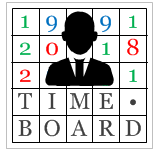About timeboard¶
timeboard creates schedules of work periods and performs calendar calculations over them. You can build standard business day calendars as well as a variety of other schedules, simple or complex.
Examples of problems solved by timeboard:
- If we have 20 business days to complete the project, when will be the deadline?
- If a person was employed from November 15 to December 22 and salary is paid monthly, how many month’s salaries has the employee earned?
- The above-mentioned person was scheduled to work Mondays, Tuesdays, Saturdays, and Sundays on odd weeks, and Wednesdays, Thursdays, and Fridays on even weeks. The question is the same.
- A 24x7 call center operates in shifts of varying length starting at 02:00, 08:00, and 18:00. An operator comes in on every fourth shift and is paid per shift. How many shifts has the operator sat in a specific month?
- With employees entering and leaving a company throughout a year, what was the average annual headcount?
Based on pandas timeseries library, timeboard gives more flexibility than pandas’s built-in business calendars. The key features of timeboard are:
- You can choose any time frequencies (days, hours, multiple-hour shifts, etc.) as work periods.
- You can create sophisticated schedules which can combine periodical patterns, seasonal variations, stop-and-resume behavior, etc.
- There are built-in standard business day calendars (in this version: for USA, UK, and Russia).
Contributing¶
timeboard is authored and maintained by Maxim Mamaev.
Please use Github issues for the feedback.
License¶
3-Clause BSD License
Copyright (c) 2018, Maxim Mamaev
All rights reserved.
Redistribution and use in source and binary forms, with or without
modification, are permitted provided that the following conditions are met:
1. Redistributions of source code must retain the above copyright notice,
this list of conditions and the following disclaimer.
2. Redistributions in binary form must reproduce the above copyright
notice, this list of conditions and the following disclaimer in the
documentation and/or other materials provided with the distribution.
3. Neither the name of the copyright holder nor the names of its
contributors may be used to endorse or promote products derived from this
software without specific prior written permission.
THIS SOFTWARE IS PROVIDED BY THE COPYRIGHT HOLDERS AND CONTRIBUTORS "AS
IS" AND ANY EXPRESS OR IMPLIED WARRANTIES, INCLUDING, BUT NOT LIMITED TO,
THE IMPLIED WARRANTIES OF MERCHANTABILITY AND FITNESS FOR A PARTICULAR
PURPOSE ARE DISCLAIMED. IN NO EVENT SHALL THE COPYRIGHT HOLDER OR
CONTRIBUTORS BE LIABLE FOR ANY DIRECT, INDIRECT, INCIDENTAL, SPECIAL,
EXEMPLARY, OR CONSEQUENTIAL DAMAGES (INCLUDING, BUT NOT LIMITED TO,
PROCUREMENT OF SUBSTITUTE GOODS OR SERVICES; LOSS OF USE, DATA, OR
PROFITS; OR BUSINESS INTERRUPTION) HOWEVER CAUSED AND ON ANY THEORY OF
LIABILITY, WHETHER IN CONTRACT, STRICT LIABILITY, OR TORT (INCLUDING
NEGLIGENCE OR OTHERWISE) ARISING IN ANY WAY OUT OF THE USE OF THIS
SOFTWARE, EVEN IF ADVISED OF THE POSSIBILITY OF SUCH DAMAGE.
Attribution¶
Logo design by Olga Mamaeva.
Icon ‘Worker’ made by Freepik from www.flaticon.com is used as an element of the logo.
